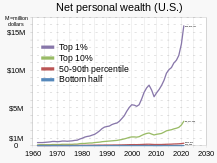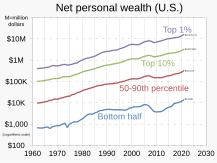Economy of the United States

 New York City, the world's principal fintech and financial center[1][2][3] and the epicenter of the world's principal metropolitan economy[4] | |
| Currency | United States dollar (Sign: $; Code: USD) |
|---|---|
| October 1 – September 30 | |
Trade organizations | WTO, G-20, G7, OECD, USMCA, APEC and others |
Country group | |
| Statistics | |
| Population | 340,332,281 (August 30, 2023)[9] |
| GDP | |
| GDP rank | |
GDP growth | |
GDP per capita | |
GDP per capita rank | |
GDP by sector |
|
GDP by component |
|
| 3% (2023)[14] | |
Population below poverty line | |
| |
Labor force | |
Labor force by occupation |
|
| Unemployment | |
Average gross salary | $5,605, monthly[22] (2023) |
| $4,246, monthly[22] (2023) | |
Final consumption expenditure | |
Gross capital formation | |
| 10-year bond 5.09% (April 2024)[23] | |
Main industries |
|
| External | |
| Exports | $3.053 trillion (2023)[26] |
Export goods |
|
Main export partners | |
| Imports | $3.827 trillion (2023)[26] |
Import goods |
|
Main import partners | |
FDI stock | |
Gross external debt | |
| Public finances | |
| |
| –6.3% of GDP (2023)[33] | |
| Revenues | $8.720 trillion[31] 29.9% of GDP (2024) |
| Expenses | $10.945 trillion[31] 37.5% of GDP (2024) Government spending in the United States |
| Economic aid | donor: ODA, $35.26 billion (2017)[34] |
| $250 billion (2024)[40] | |
All values, unless otherwise stated, are in US dollars. | |
| This article is part of a series on the |
| Economy of the United States |
|---|
 |
The United States is a highly developed mixed economy.[41][42][43] It is the world's largest economy by nominal GDP; it is also the second largest by purchasing power parity (PPP), behind China.[44] It has the world's sixth highest per capita GDP (nominal) and the eighth highest per capita GDP (PPP) as of 2024.[10] The U.S. accounted for 26% of the global economy in 2023 in nominal terms, and about 15.5% in PPP terms.[11][45] The U.S. dollar is the currency of record most used in international transactions and is the world's reserve currency, backed by a large U.S. treasuries market, its role as the reference standard for the petrodollar system, and its linked eurodollar.[46] Several countries use it as their official currency and in others it is the de facto currency.[47] Since the end of World War II, the economy has achieved relatively steady growth, low unemployment and inflation, and rapid advances in technology.[12]
The American economy is fueled by high productivity, well developed transportation infrastructure, and extensive natural resources.[48] Americans have the sixth highest average household and employee income among OECD member states.[49] In 2021, they had the highest median household income.[50] The U.S. has one of the world's highest income inequalities among the developed countries.[51][52][53] The largest U.S. trading partners are Canada, Mexico, China, Japan, Germany, South Korea, the United Kingdom, Taiwan, India, and Vietnam.[54] The U.S. is the world's largest importer and second largest exporter.[55] It has free trade agreements with several countries, including Canada and Mexico (through the USMCA), Australia, South Korea, Israel, and several others that are in effect or under negotiation.[56] The U.S. has a highly flexible labor market, where the industry adheres to a hire-and-fire policy, and job security is relatively low.[57][58] Among OECD nations, the U.S. has a highly efficient and strong social security system; social expenditure stood at roughly 30% of GDP.[8][59][7]
The United States is the world's largest producer of petroleum and natural gas.[60] In 2016, it was the world's largest trading country[61] and second largest manufacturer, with American manufacturing making up a fifth of the global total.[62] The U.S. not only has the largest internal market for goods, but also dominates the services trade. Total U.S. trade was $4.2 trillion in 2018.[63] Of the world's 500 largest companies, 121 are headquartered in the U.S.[64] The U.S. has the world's highest number of billionaires, with total wealth of $3.0 trillion.[65][66] U.S. commercial banks had $22.9 trillion in assets in December 2022.[67] U.S. global assets under management had more than $30 trillion in assets.[68][69] During the Great Recession of 2008, the U.S. economy suffered a significant decline.[70][71] The American Reinvestment and Recovery Act was enacted by the United States Congress, and in the ensuing years the U.S. experienced the longest economic expansion on record by July 2019.[72][73][74][75]
The New York Stock Exchange and Nasdaq are the world's largest stock exchanges by market capitalization and trade volume.[76][77] The U.S. has the world's largest gold reserve, with over 8,000 tonnes of gold.[78] In 2014, the U.S. economy was ranked first in international ranking on venture capital[79] and global research and development funding.[80] The U.S. spends around 3.46% of GDP on cutting-edge research and development across various sectors of the economy.[81] The U.S. has produced the world's highest number of Nobel laureates in the economics field.[82] It is also the world's fourth largest high-technology exporter.[83] The U.S. ranks second in the world by number of patent applications.[84] Consumer spending comprised 68% of the U.S. economy in 2022,[85] while its labor share of income was 44% in 2021.[86] The U.S. has the world's largest consumer market.[87] The nation's labor market has attracted immigrants from all over the world and its net migration rate is among the highest in the world.[88] The U.S. is one of the top-performing economies in studies such as the Ease of Doing Business Index, the Global Competitiveness Report, and others.[89]
History
[edit]Colonial era and 18th century
[edit]The economic history of the United States began with British settlements along the Eastern seaboard in the 17th and 18th centuries. After 1700, the United States gained population rapidly, and imports as well as exports grew along with it. Africa, Asia, and most frequently Europe, contributed to the trade of the colonies.[90] These 13 colonies gained independence from the British Empire in the late 18th century[91] and quickly grew from colonial economies towards an economy focused on agriculture.[92]
19th century
[edit]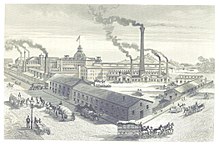
In 180 years, the United States grew to become a huge, integrated, and industrialized economy, which made up about a fifth of the world economy. In that process, the U.S. GDP per capita rose past that of many other countries, supplanting the British Empire at the top. The economy maintained high wages, attracting immigrants by the millions from all over the world.[93] In the 1820s and 1830s, mass production shifted much of the economy from artisans to factories. New government regulations strengthened patents.
Early in the 19th century, more than 80 percent of Americans engaged in farming. Most of the manufacturing centered on the first stages of the transformation of raw materials, with lumber and sawmills, textiles, and boots and shoes leading the way. The rich natural resources contributed to the rapid economic expansion of the nineteenth century. Ample land allowed the number of farmers to keep growing; but activity in manufacturing, services, transportation, and other sectors grew much faster, so that by 1860 the population was only about 50 percent rural, down from over 80 percent.[94]
In the 19th century, recessions frequently coincided with financial crises. The Panic of 1837 was followed by a five-year depression, marked by bank failures and unprecedented unemployment.[95] Because of the great changes in the economy over the centuries, it is difficult to compare the severity of modern recessions to that of early recessions.[96] Recessions after World War II appear to have been less severe than earlier recessions, but the reasons for this are unclear.[97]
20th century
[edit]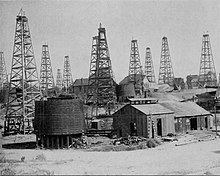


At the beginning of the century, new innovations and improvements in existing innovations opened the door for improvements in the standard of living among American consumers. Many firms grew large by taking advantage of economies of scale and better communication to run nationwide operations. Concentration in these industries raised fears of monopolies that would drive prices higher and output lower, but many of these firms were cutting costs so fast that trends were towards lower prices and more output in these industries. Many workers shared the success of these large firms, which typically offered the highest wages in the world.[98]
The United States has been the world's largest national economy in terms of GDP since around 1890.[99] For many years following the Great Depression of the 1930s, when the danger of recession appeared most serious, the government strengthened the economy by spending heavily itself or cutting taxes so that consumers would spend more and by fostering rapid growth in the money supply, which also encouraged more spending. Ideas about the best tools for stabilizing the economy changed substantially between the 1930s and the 1980s. From the New Deal era that began in 1933 to the Great Society initiatives of the 1960s, national policymakers relied principally on fiscal policy to influence the economy.[100]
During the world wars of the twentieth century, the United States fared better than the rest of the combatants because none of the First World War and relatively little of the Second World War were fought on American territory (and none on the then-48 states). Yet, even in the United States, the wars meant sacrifice. During the peak of Second World War activity, nearly 40 percent of U.S. GDP was devoted to war production. Decisions about large swaths of the economy were largely made for military purposes, and nearly all relevant inputs were allocated to the war effort. Many goods were rationed, prices and wages controlled, and many durable consumer goods were no longer produced. Large segments of the workforce were inducted into the military and paid half their wages; roughly half of those were sent into harm's way.[101]
The approach, advanced by British economist John Maynard Keynes, gave elected officials a leading role in directing the economy since spending and taxes are controlled by the U.S. president and Congress. The "Baby Boom" saw a dramatic increase in fertility in the period 1942–1957; it was caused by delayed marriages and childbearing during the depression years, a surge in prosperity, a demand for suburban single-family homes (as opposed to inner city apartments), and new optimism about the future. The boom peaked around 1957 and then began to fade.[102] A period of high inflation, interest rates, and unemployment after 1973 weakened confidence in fiscal policy as a tool for regulating the overall pace of economic activity.[103]
The U.S. economy grew by an average of 3.8% from 1946 to 1973, while real median household income surged by 74% (or 2.1% a year).[104][105]
Since the 1970s, several emerging countries have begun to close the economic gap with the United States. In most cases, this has been due to moving the manufacture of goods formerly made in the U.S. to countries where they could be made for sufficiently less money to cover the cost of shipping plus a higher profit. In other cases, some countries have gradually learned to produce the same products and services that previously only the U.S. and a few other countries could produce. Real income growth in the U.S. has slowed. In the 1970s and 1980s, it was popular in the U.S. to believe that Japan's economy would surpass that of the U.S., but this did not occur.[106]
21st century
[edit]
The United States economy experienced a recession in 2001 with an unusually slow jobs recovery, with the number of jobs not regaining the February 2001 level until January 2005.[107] This "jobless recovery" overlapped with the building of a housing bubble and arguably a wider debt bubble, as the ratio of household debt to GDP rose from a record level of 70% in Q1 2001 to 99% in Q1 2008. Homeowners were borrowing against their bubble-priced homes to fuel consumption, driving up their debt levels while providing an unsustainable boost to GDP. When housing prices began falling in 2006, the value of securities backed by mortgages fell dramatically, causing the equivalent of a bank run in the essentially unregulated non-depository banking system, which had outgrown the traditional, regulated depository banking system. Many mortgage companies and other non-depository banks (e.g., investment banks) faced a worsening crisis in 2007–2008, with the banking crisis peaking in September 2008, with the bankruptcy of Lehman Brothers and bailouts of several other financial institutions.[108]
The Bush administration (2001–2009) and Obama administrations (2009–2017) applied banking bailout programs and Keynesian stimulus via high government deficits, while the Federal Reserve maintained near-zero interest rates. These measures helped the economy recover, as households paid down debts in 2009–2012, the only years since 1947 where this occurred,[109] presenting a significant barrier to recovery.[108] Real GDP regained its pre-crisis (late 2007) peak by 2011,[110] household net worth by Q2 2012,[111] non-farm payroll jobs by May 2014,[107] and the unemployment rate by September 2015.[112] Each of these variables continued into post-recession record territory following those dates, with the U.S. recovery becoming the second longest on record in April 2018.[75]
A significant recession, as defined lost economic output, occurred during the financial crisis of 2007–2008, when GDP fell by 5.0% from the spring of 2008 to the spring of 2009. Other significant recessions took place in 1957–1958, when GDP fell 3.7% following the 1973 oil crisis, with a 3.1% fall from late 1973 to early 1975, and in the 1981–1982 recession, when GDP dropped by 2.9%.[113][114] Recent, mild recessions have included the 1990–1991 downturn, when output fell by 1.3%, and the 2001 recession, in which GDP slid by 0.3%; the 2001 downturn lasted just eight months.[114] The most vigorous, sustained periods of growth, on the other hand, took place from early 1961 to mid-1969, with an expansion of 53% (5.1% a year), from mid-1991 to late 2000, at 43% (3.8% a year), and from late 1982 to mid-1990, at 37% (4% a year).[113]
Debt held by the public, a measure of national debt, has risen throughout the 21st century. Rising from 31% in 2000 to 52% in 2009, and reaching 77% of GDP in 2017, the U.S. ranked 43rd highest in debt out of 207 countries.[115]
COVID-19 pandemic
[edit]This section needs to be updated. (October 2021) |
In the first two quarters of 2020 amid Donald Trump's presidency,[116] the U.S. economy suffered major setbacks beginning in March 2020, due to the novel coronavirus and having to "shut-down" major sectors of the American economy.[117] As of March 2020, US exports of automobiles and industrial machines had plummeted as a result of the worldwide pandemic.[118] Social distancing measures which took effect in March 2020, and which negatively impacted the demand for goods and services, resulted in the US GDP declining at a 4.8% annualized rate in the first quarter, the steepest pace of contraction in output since the fourth quarter of 2008.[119] US retails sales dropped a record 8.7% in March alone. The US airline industry had also been hit hard, seeing a sharp decline in its revenues.[120] The COVID-19 recession has been widely described as the most severe global economic downturn since the Great Depression and "far worse" than the Great Recession.[121][122][123][124]

In May 2020, CNN gave an analysis based on unemployment data that the US economy was perhaps the worst that it had been since the 1930s.[126] By May 8, the US had reached a record 14.7 percent unemployment, with 20.5 million jobs lost in April.[127] The Chairman of the US Federal Reserve, Jerome Powell, warned that it may take "an extended time" before the US economy fully recovers from weak economic growth, due to the pandemic, and that in the foreseeable future the US can expect "low productivity growth and stagnant incomes".[128] By May 31, 2020, more than forty million Americans had filed for unemployment benefits.[129]
By June 2020, the slump in US continental flights due to the coronavirus pandemic had resulted in the US government temporarily halting service of fifteen US airlines to 75 domestic airports.[130] The New York Times reported on June 10, 2020, that "the United States budget deficit grew to a record $1.88 trillion for the first eight months of this fiscal year."[131]
The US economy recovered from the COVID-19 pandemic in 2021, growing by 5.7%, which was its best performance since Ronald Reagan's presidency (1981–1989).[132]
2021–2022 marked a historical inflation surge in the United States, with the Consumer Price Index inflation rate hitting 9.1% higher in June 2022 than June 2021, constituting a 41-year high inflation rate with critics blaming the Federal Reserve among other factors.[133] Inflation rate reached 4.9% in April 2023, which was roughly 3% above the Federal Reserve's 2% target rate.[134]
Data
[edit]The following table shows the main economic indicators in 1980–2023 (with IMF staff estimates in 2024–2028). Inflation below 5% is in green.[135]
| Year | GDP (in Bil. US$PPP) | GDP per capita (in US$ PPP) | GDP (in Bil. US$nominal) | GDP per capita (in US$ nominal) | GDP growth (real) | Inflation rate (in Percent) | Unemployment (in Percent) | Government debt (in % of GDP) |
|---|---|---|---|---|---|---|---|---|
| 1980 | 2,857.3 | 12,552.9 | 2,857.3 | 12,552.9 | 7.2% | n/a | ||
| 1981 | n/a | |||||||
| 1982 | n/a | |||||||
| 1983 | n/a | |||||||
| 1984 | n/a | |||||||
| 1985 | n/a | |||||||
| 1986 | n/a | |||||||
| 1987 | n/a | |||||||
| 1988 | n/a | |||||||
| 1989 | n/a | |||||||
| 1990 | n/a | |||||||
| 1991 | n/a | |||||||
| 1992 | n/a | |||||||
| 1993 | n/a | |||||||
| 1994 | n/a | |||||||
| 1995 | n/a | |||||||
| 1996 | n/a | |||||||
| 1997 | n/a | |||||||
| 1998 | n/a | |||||||
| 1999 | n/a | |||||||
| 2000 | n/a | |||||||
| 2001 | 53.1% | |||||||
| 2002 | ||||||||
| 2003 | ||||||||
| 2004 | ||||||||
| 2005 | ||||||||
| 2006 | ||||||||
| 2007 | ||||||||
| 2008 | ||||||||
| 2009 | ||||||||
| 2010 | ||||||||
| 2011 | ||||||||
| 2012 | ||||||||
| 2013 | ||||||||
| 2014 | ||||||||
| 2015 | ||||||||
| 2016 | ||||||||
| 2017 | ||||||||
| 2018 | ||||||||
| 2019 | ||||||||
| 2020 | ||||||||
| 2021 | ||||||||
| 2022 | ||||||||
| 2023 | ||||||||
| 2024 | ||||||||
| 2025 | ||||||||
| 2026 | ||||||||
| 2027 | ||||||||
| 2028 | ||||||||
| 2029 |
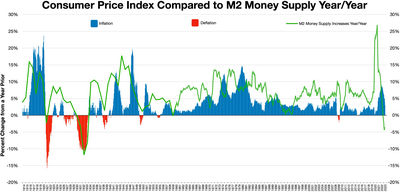
GDP
[edit]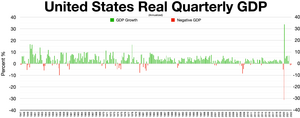
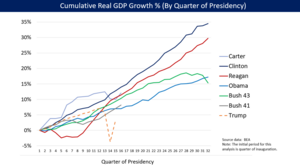
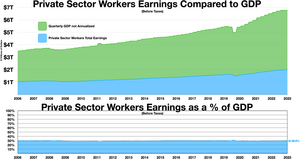
Private sector workers made ~$2 trillion or about 29.6% of all money earned in Q3 2023 (before taxes)
U.S. nominal GDP was $19.5 trillion in 2017, the largest in the world. Annualized, nominal GDP reached $20.1 trillion in Q1 2018, the first time it exceeded $20 trillion. About 70% of U.S. GDP is personal consumption, with business investment 18%, government 17% (federal, state and local but excluding transfer payments such as Social Security, which is in consumption) and net exports a negative 3% due to the U.S. trade deficit.[137] Real gross domestic product, a measure of both production and income, grew by 2.3% in 2017, vs. 1.5% in 2016 and 2.9% in 2015. Real GDP grew at a quarterly annualized rate of 2.2% in Q1 2018, 4.2% in Q2 2018, 3.4% in Q3 2018 and 2.2% in Q4 2018; the Q2 rate was the best growth rate since Q3 2014, and the overall yearly GDP growth of 2.9% in 2018 was the best performance of the economy in a decade.[138] In 2020, the growth rate of the GDP has started to drop as a result of the COVID-19 pandemic, resulting in the GDP shrinking at a quarterized annual growth rate of −5.0% in Q1 2020[citation needed] and −32.9% in Q2 2020,[citation needed] respectively.
As of 2014, China passed the U.S. as the largest economy in GDP (PPP) terms, measured at purchasing power parity conversion rates. The U.S. had the highest GDP (PPP) figures for more than a century prior to that milestone; China has more than tripled the U.S. growth rate for each of the past 40 years. As of 2017, the European Union as an aggregate had a GDP roughly 5% larger than the U.S., although the former is a political union not a country. The United States', however, remained the world's largest economy with the highest nominal GDP.[139]
Real GDP per capita (measured in 2009 dollars) was $52,444 in 2017 and has been growing each year since 2010. It grew 3.0% per year on average in the 1960s, 2.1% in the 1970s, 2.4% in the 1980s, 2.2% in the 1990s, 0.7% in the 2000s, and 0.9% from 2010 to 2017.[140] Reasons for slower growth since 2000 are debated by economists and may include aging demographics, slower population and growth in labor force, slower productivity growth, reduced corporate investment, greater income inequality reducing demand, lack of major innovations, and reduced labor power.[141] The U.S. ranked 20th out of 220 countries in GDP per capita in 2017.[142] Among the modern U.S. Presidents, Bill Clinton had the highest cumulative percent real GDP increase during his two terms, Reagan second and Obama third.[138]
The development of the nation's GDP according to World Bank:[143] U.S. real GDP grew by an average of 1.7% from 2000 to the first half of 2014, a rate around half the historical average up to 2000.[144]
By economic sector
[edit]Nominal GDP sector composition
[edit]
Nominal GDP sector composition, 2015 (in millions of dollars) at 2005 constant prices[145]
| Country/Economy | Real GDP | Agri. | Indus. | Serv. |
|---|---|---|---|---|
| World | 60,093,221 | 1,968,215 | 16,453,140 | 38,396,695 |
| 15,160,104 | 149,023 | 3,042,332 | 11,518,980 |
Nominal GDP Sector Composition, 2016 (in millions of dollars) at current prices.[146]
| Country/Economy | Nominal GDP | Agri. | Indus. | Serv. | |
|---|---|---|---|---|---|
| 18,624,450 | 204,868.95 | 3,613,143.3 | 14,806,437.75 | ||
| *Percentages from CIA World Factbook[147] | |||||
Employment
[edit]
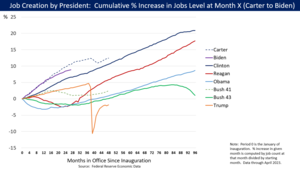
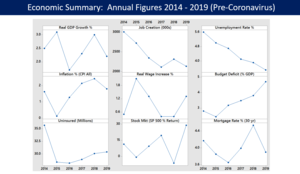
There were approximately 160.4 million people in the U.S. labor force in 2017, the fourth largest labor force in the world behind China, India, and the European Union.[149] The government (federal, state and local) employed 22 million in 2010.[150] Small businesses are the nation's largest employer, representing 37% of American workers.[151] The second-largest share of employment belongs to large businesses employing 36% of the U.S. workforce.[151] White collar workers comprise 44% of the workforce as of 2022, up from 34% in 2000.[152]
The nation's private sector employs 85% of working Americans. Government accounts for 14% of all U.S. workers. Over 99% of all private employing organizations in the U.S. are small businesses.[151] The 30 million small businesses in the U.S. account for 64% of newly created jobs (those created minus those lost).[151] Jobs in small businesses accounted for 70% of those created in the last decade.[153]
The proportion of Americans employed by small business versus large business has remained relatively the same year by year as some small businesses become large businesses and just over half of small businesses survive for more than five years.[151] Amongst large businesses, several of the largest companies and employers in the world are American companies. Amongst them are Walmart, which is both the largest company and the largest private sector employer in the world. Walmart employs 2.1 million people worldwide and 1.4 million in the U.S. alone.[154][155]
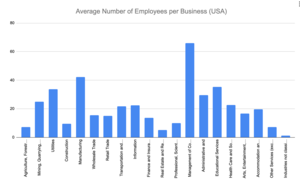
There are nearly thirty million small businesses in the U.S.. Minorities such as Hispanics, African Americans, Asian Americans, and Native Americans (35% of the country's population),[156] own 4.1 million of the nation's businesses. Minority-owned businesses generate almost $700 billion in revenue, and they employ almost five million workers in the U.S.[151][157] Americans have the highest average employee income among OECD nations.[158] The median household income in the U.S. as of 2008 is $52,029.[159] About 284,000 working people in the U.S. have two full-time jobs and 7.6 million have part-time ones in addition to their full-time employments.[150] Out of all working individuals in the U.S., 12% belong to a labor union and most union members work for the government.[150] The decline of union membership in the U.S. over the last several decades parallels that of labor's share of the economy.[160][161][162] The World Bank ranks the United States first in the ease of hiring and firing workers.[163] The United States is the only advanced economy that does not legally guarantee its workers paid vacation or paid sick days, and is one of just a few countries in the world without paid family leave as a legal right, with the others being Papua New Guinea, Suriname and Liberia.[164][165][166] In 2014 and again in 2020, the International Trade Union Confederation graded the U.S. a 4 out of 5+, its third-lowest score, on the subject of powers and rights granted to labor unions.[167][168] Similarly, a 2023 study published by Oxfam found that the United States ranks among the worst among developed countries for labor protections.[169][170] Some scholars, including business theorist Jeffrey Pfeffer and political scientist Daniel Kinderman, posit that contemporary employment practices in the United States relating to the increased performance pressure from management, and the hardships imposed on employees such as toxic working environments, precarity, and long hours, could be responsible for 120,000 excess deaths annually, making the workplace the fifth leading cause of death in the United States.[171][172][173]
Unemployment
[edit]
As of December 2017, the unemployment rate in the U.S. was 4.1%[174] or 6.6 million people.[175] The government's broader U-6 unemployment rate, which includes the part-time underemployed, was 8.1%[176] or 8.2 million people. These figures were calculated with a civilian labor force of approximately 160.6 million people,[177] relative to a U.S. population of approximately 327 million people.[178]
Between 2009 and 2010, following the Great Recession, the emerging problem of jobless recoveries resulted in record levels of long-term unemployment with more than six million workers looking for work for more than six months as of January 2010. This particularly affected older workers.[179] A year after the recession ended in June 2009, immigrants gained 656,000 jobs in the U.S., while U.S.-born workers lost more than a million jobs, due in part to an aging country (relatively more white retirees) and demographic shifts.[180] In April 2010, the official unemployment rate was 9.9%, but the government's broader U-6 unemployment rate was 17.1%.[181] Between February 2008 and February 2010, the number of people working part-time for economic reasons (i.e., would prefer to work full-time) increased by 4.0 million to 8.8 million, an 83% increase in part-time workers during the two-year period.[182]
By 2013, although the unemployment rate had fallen below 8%, the record proportion of long term unemployed and continued decreasing household income remained indicative of a jobless recovery.[183] However, the number of payroll jobs returned to its pre-recession (November 2007) level by May 2014 as the economy recovered.[184]
After being higher in the post-war period, the U.S. unemployment rate fell below the rising eurozone unemployment rate in the mid-1980s and has remained significantly lower almost continuously since.[185][186][187] In 1955, 55% of Americans worked in services, between 30% and 35% in industry, and between 10% and 15% in agriculture. By 1980, over 65% were employed in services, between 25% and 30% in industry, and less than 5% in agriculture.[188] Male unemployment continued to be significantly higher than those of females (at 9.8% vs. 7.5% in 2009). The unemployment among Caucasians continues being much lower than those for African-Americans (at 8.5% vs. 15.8% also in 2009).[189]
The youth unemployment rate was 18.5% in July 2009, the highest rate in that month since 1948.[190] The unemployment rate of young African Americans was 28.2% in May 2013.[191]
The unemployment rate reached an all-time high of 14.7% in April 2020 before falling back to 11.1% in June 2020. Due to the effects of the COVID-19 pandemic, Q2 GDP in the US fell 32.9% in 2020.[192][193][194] The unemployment rate continued its rapid decline falling to 3.9% in 2021.[195] It reached 3.7% in May 2023.[196]
Employment by sector
[edit]U.S. employment, as estimated in 2012, is divided into 79.7% in the service sector, 19.2% in the manufacturing sector, and 1.1% in the agriculture sector.[197]
Income and wealth
[edit]


Income measures
[edit]Real (i.e., inflation-adjusted) median household income, a good measure of middle-class income, was $59,039 in 2016, a record level. However, it was just above the previous record set in 1998, indicating the purchasing power of middle-class family income has been stagnant or down for much of the past twenty years.[199] During 2013, employee compensation was $8.969 trillion, while gross private investment totals $2.781 trillion.[200]
Americans have the highest average household income among OECD nations, and in 2010 had the fourth-highest median household income, down from second-highest in 2007.[201][158] According to one analysis middle-class incomes in the United States fell into a tie with those in Canada in 2010, and may have fallen behind by 2014, while several other advanced economies have closed the gap in recent years.[202]
Income inequality
[edit]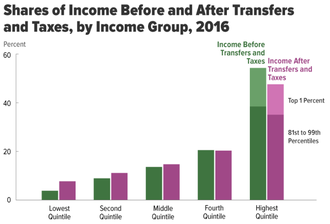
| This article is part of a series on |
| Income in the United States of America |
|---|
 |
| |
Income inequality has fluctuated considerably in the United States since measurements began around 1915, moving in an arc between peaks in the 1920s and 2000s, with a 30-year period of relatively lower inequality between 1950 and 1980.
The U.S. has the highest level of income inequality among its (post-)industrialized peers.[203] When measured for all households, U.S. income inequality is comparable to other developed countries before taxes and transfers, but is among the highest after taxes and transfers, meaning the U.S. shifts relatively less income from higher income households to lower income households. In 2016, average market income was $15,600 for the lowest quintile and $280,300 for the highest quintile. The degree of inequality accelerated within the top quintile, with the top 1% at $1.8 million, approximately 30 times the $59,300 income of the middle quintile.[204]
The economic and political impacts of inequality may include slower GDP growth, reduced income mobility, higher poverty rates, greater usage of household debt leading to increased risk of financial crises, and political polarization.[205][206] Causes of inequality may include executive compensation increasing relative to the average worker, financialization, greater industry concentration, lower unionization rates, lower effective tax rates on higher incomes, and technology changes that reward higher educational attainment.[207]
Measurement is debated, as inequality measures vary significantly, for example, across datasets[208][209] or whether the measurement is taken based on cash compensation (market income) or after taxes and transfer payments. The Gini coefficient is a widely accepted statistic that applies comparisons across jurisdictions, with a zero indicating perfect equality and 1 indicating maximum inequality. Further, various public and private data sets measure those incomes, e.g., from the Congressional Budget Office (CBO),[204] the Internal Revenue Service, and Census.[210] According to the Census Bureau, income inequality reached then record levels in 2018, with a Gini of 0.485,[211] Since then the Census Bureau have given values of 0.488 in 2020 and 0.494 in 2021, per pre-tax money income.[212]
U.S. tax and transfer policies are progressive and therefore reduce effective income inequality, as rates of tax generally increase as taxable income increases. As a group, the lowest earning workers, especially those with dependents, pay no income taxes and may actually receive a small subsidy from the federal government (from child credits and the Earned Income Tax Credit).[213] The 2016 U.S. Gini coefficient was .59 based on market income, but was reduced to .42 after taxes and transfers, according to Congressional Budget Office (CBO) figures. The top 1% share of market income rose from 9.6% in 1979 to a peak of 20.7% in 2007, before falling to 17.5% by 2016. After taxes and transfers, these figures were 7.4%, 16.6%, and 12.5%, respectively.[204]Household net worth and wealth inequality
[edit]As of Q4 2017, total household net worth in the United States was a record $99 trillion, an increase of $5.2 trillion from 2016. This increase reflects both stock market and housing price gains. This measure has been setting records since Q4 2012.[215] If divided evenly, the $99 trillion represents an average of $782,000 per household (for about 126.2 million households) or $302,000 per person. However, median household net worth (i.e., half of the families above and below this level) was $97,300 in 2016. The bottom 25% of families had a median net worth of zero, while the 25th to 50th percentile had a median net worth of $40,000.[216]
Wealth inequality is more unequal than income inequality, with the top 1% households owning approximately 42% of the net worth in 2012, versus 24% in 1979.[217] According to a September 2017 report by the Federal Reserve, wealth inequality is at record highs; the top 1% controlled 38.6% of the country's wealth in 2016.[218] The Boston Consulting Group posited in June 2017 report that 1% of the Americans will control 70% of country's wealth by 2021.[219]
The top 10% wealthiest possess 80% of all financial assets.[220] Wealth inequality in the U.S. is greater than in most developed countries other than Sweden.[221] Inherited wealth may help explain why many Americans who have become rich may have had a "substantial head start".[222][223] In September 2012, according to the Institute for Policy Studies, "over 60 percent" of the Forbes richest 400 Americans "grew up in substantial privilege".[224] Median household wealth fell 35% in the U.S., from $106,591 to $68,839 between 2005 and 2011, due to the Great Recession, but has since recovered as indicated above.[225]
About 30% of the entire world's millionaire population resides in the United States (as of 2009[update]).[226] The Economist Intelligence Unit estimated in 2008 that there were 16,600,000 millionaires in the U.S.[227] Furthermore, 34% of the world's billionaires are American (in 2011).[228][229]
Home ownership
[edit]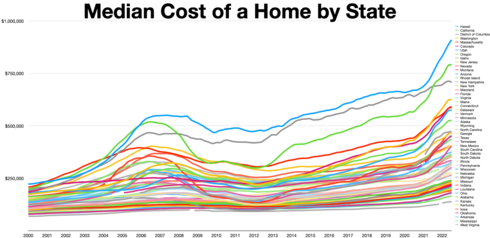
The U.S. home ownership rate in Q1 2018 was 64.2%, well below the all-time peak of 69.2% set in Q4 2004 during a housing bubble. Millions of homes were lost to foreclosure during the Great Recession of 2007–2009, bringing the ownership rate to a trough of 62.9% in Q2 2016. The average ownership rate from 1965 to 2017 was 65.3%.[230]
The average home in the United States has more than 700 square feet per person (65 square meters), which is 50%–100% more than the average in other high-income countries. Similarly, ownership rates of gadgets and amenities are relatively high compared to other countries.[231][232][233]
It was reported by Pew Research Center in 2016 that, for the first time in 130 years, Americans aged 18 to 34 are more likely to live with their parents than in any other housing situation.[234]
In one study by ATTOM Data Solutions, in 70% of the counties surveyed, homes are increasingly unaffordable for the average U.S. worker.[235]
As of 2018, the number of U.S. citizens residing in their vehicles increased in major cities with significantly higher than average housing costs such as Los Angeles, Portland and San Francisco.[236][237]
According to CNBC, the median sale price for a U.S. home in 2017 was US$199,200.[238] By February 2023, the median U.S. home sale price grew to US$392,000 according to Statista.[239] The US has a country-wide housing shortage caused by insufficient housing construction (which declined severely after the 2008 Great Recession), and has caused rents and home prices to rise to increasingly unaffordable levels, with one estimate of the shortage being 3.8 million units in 2019, with this shortage having gotten worse during and since the pandemic.[240][241]
As of January 2024, in roughly half of cities in the U.S., workers need incomes of $100,000 or more in order to purchase a home as a result of rising housing prices and interest rate hikes.[242]
Profits and wages
[edit]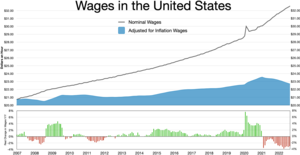
Real wages (wages adjusted for inflation) for most workers in the United States and median incomes have either declined or remained stagnant for the last twenty to forty years.[243][244][245][246] A 2020 microanalysis demonstrated that in the preceding four decades labor's share of national output declined while over the same period the profit share of the same output increased.[247]
In 1970, wages represented more than 51% of the U.S. GDP and profits were less than 5%. But by 2013, wages had fallen to 44% of the economy, while profits had more than doubled to 11%.[248] Inflation-adjusted ("real") per capita disposable personal income rose steadily in the U.S. from 1945 to 2008, but has since remained generally level.[249][250]
In 2005, median personal income for those over the age of 18 ranged from $3,317 for an unemployed, married Asian American female[251] to $55,935 for a full-time, year-round employed Asian American male.[252] According to the U.S. Census men tended to have higher income than women while Asians and Whites earned more than African Americans and Hispanics. The overall median personal income for all individuals over the age of 18 was $24,062[253] ($32,140 for those age 25 or above) in the year 2005.[254]
As a reference point, the minimum wage rate in 2009 and 2017 was $7.25 per hour or $15,080 for the 2080 hours in a typical work year. The minimum wage is a little more than the poverty level for a single person unit and about 50% of the poverty level for a family of four.
According to an October 2014 report by the Pew Research Center, real wages have been flat or falling for the last five decades for most U.S. workers, regardless of job growth.[255] Bloomberg reported in July 2018 that real GDP per capita has grown substantially since the Great Recession.[256]
An August 2017 survey by CareerBuilder found that eight out of ten U.S. workers live paycheck to paycheck. CareerBuilder spokesman Mike Erwin blamed "stagnant wages and the rising cost of everything from education to many consumer goods".[257] According to a survey by the federal Consumer Financial Protection Bureau on the financial well-being of U.S. citizens, roughly half have trouble paying bills, and more than one third have faced hardships such as not being able to afford a place to live, running out of food, or not having enough money to pay for medical care.[258] According to journalist and author Alissa Quart, the cost of living is rapidly outpacing the growth of salaries and wages, including those for traditionally secure professions such as teaching. She writes that "middle-class life is now 30% more expensive than it was 20 years ago."[259]
In February 2019, the Federal Reserve Bank of New York reported that seven million U.S. citizens are three months or more behind on their car payments, setting a record. This is considered a red flag by economists, that Americans are struggling to pay bills in spite of a low unemployment rate.[260] A May 2019 poll conducted by NPR found that among rural Americans, 40% struggle to pay for healthcare, food and housing, and 49% could not pay cash for a $1,000 emergency, and would instead choose to borrow in order to pay for such an unexpected emergency expense.[261] Some experts assert that the US has experienced a "two-tier recovery", which has benefitted 60% of the population, while the other 40% on the "lower tier" have been struggling to pay bills as the result of stagnant wages, increases in the cost of housing, education and healthcare, and growing debts.[262]
A 2021 study by the National Low Income Housing Coalition found that workers would have to make at least $24.90 an hour to be able to afford (meaning 30% of a person's income or less) renting a standard two-bedroom home or $20.40 for a one-bedroom home anywhere in the US. The former is 3.4 times higher than the current federal minimum wage.[263]
The USCB reported in September 2023 that incomes fell last year by 2.3% from 2021, which is the third consecutive year incomes have declined.[264]
Poverty
[edit]
Starting in the 1980s relative poverty rates have consistently exceeded those of other wealthy nations, though analyses using a common data set for comparisons tend to find that the U.S. has a lower absolute poverty rate by market income than most other wealthy nations.[265] Extreme poverty in the United States, meaning households living on less than $2 per day before government benefits, doubled from 1996 levels to 1.5 million households in 2011, including 2.8 million children.[266] In 2013, child poverty reached record high levels, with 16.7 million children living in food insecure households, about 35% more than 2007 levels.[267] As of 2015, 44 percent of children in the United States live with low-income families.[268]
In 2016, 12.7% of the U.S. population lived in poverty, down from 13.5% in 2015. The poverty rate rose from 12.5% in 2007 before the Great Recession to a 15.1% peak in 2010, before falling back to just above the 2007 level. In the 1959–1962 period, the poverty rate was over 20%, but declined to the all-time low of 11.1% in 1973 following the War on Poverty begun during the Lyndon Johnson presidency.[269] In June 2016, The IMF warned the United States that its high poverty rate needs to be tackled urgently.[270]

The population in extreme-poverty neighborhoods rose by one third from 2000 to 2009.[272] People living in such neighborhoods tend to suffer from inadequate access to quality education; higher crime rates; higher rates of physical and psychological ailment; limited access to credit and wealth accumulation; higher prices for goods and services; and constrained access to job opportunities.[272] As of 2013, 44% of America's poor are considered to be in "deep poverty", with an income 50% or more below the government's official poverty line.[273]
According to the US Department of Housing and Urban Development's Annual Homeless Assessment Report, as of 2017[update] there were around 554,000 homeless people in the United States on a given night,[274] or 0.17% of the population. Almost two thirds stayed in an emergency shelter or transitional housing program and the other third were living on the street, in an abandoned building, or another place not meant for human habitation. About 1.56 million people, or about 0.5% of the U.S. population, used an emergency shelter or a transitional housing program between October 1, 2008, and September 30, 2009.[275] Around 44% of homeless people are employed.[276] Homelessness increased from 2016 to 2020, along with deaths among the homeless population.[277]

The United States has one of the least extensive social safety nets in the developed world, reducing both relative poverty and absolute poverty by considerably less than the mean for wealthy nations.[278][279][280][281][282] Some experts posit that those in poverty live in conditions rivaling the developing world.[283][284] A May 2018 report by the U.N. Special Rapporteur on extreme poverty and human rights found that over five million people in the United States live "in 'Third World' conditions".[285] Poverty is the fourth leading risk factor for premature death annually, according to a 2023 study published in JAMA.[286][287][288] Over the last three decades the poor in America have been incarcerated at a much higher rate than their counterparts in other developed nations, with penal confinement being "commonplace for poor men of working age".[289] Some scholars contend that the shift to neoliberal social and economic policies starting in the late 1970s has expanded the penal state, retrenched the social welfare state, deregulated the economy and criminalized poverty, ultimately "transforming what it means to be poor in America".[290][291][292]
Sociologist Matthew Desmond writes in his 2023 book Poverty, by America that the US "offers some of the lowest wages in the industrialized world," which has "swelled the ranks of the working poor, most of whom are thirty-five or older."[293] Social scientist Mark Robert Rank asserts that the high rates of poverty in the U.S. can largely be explained as structural failures at the economic and political levels.[294]
Health care
[edit]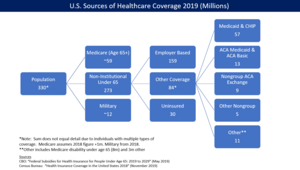
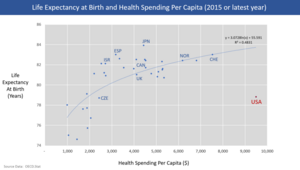
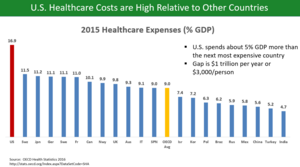
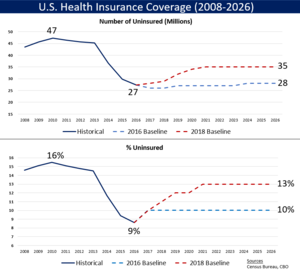
Parts of this article (those related to uninsured statistics) need to be updated. (October 2016) |
Coverage
[edit]The American system is a mix of public and private insurance. The government provides insurance coverage for approximately 53 million elderly via Medicare, 62 million lower-income persons via Medicaid, and 15 million military veterans via the Veteran's Administration. About 178 million employed by companies receive subsidized health insurance through their employer, while 52 million other persons directly purchase insurance either via the subsidized marketplace exchanges developed as part of the Affordable Care Act or directly from insurers. The private sector delivers healthcare services, with the exception of the Veteran's Administration, where doctors are employed by the government.[298]
Multiple surveys indicate the number of uninsured fell between 2013 and 2016 due to expanded Medicaid eligibility and health insurance exchanges established due to the Patient Protection and Affordable Care Act, also known as the "ACA" or "Obamacare". According to the United States Census Bureau, in 2012 there were 45.6 million people in the US (14.8% of the under-65 population) who were without health insurance. This figure fell by 18.3 million (40%) to 27.3 million (8.6% of the under-65 population) by 2016.[299]
However, under President Trump these gains in healthcare coverage have begun to reverse. The Commonwealth Fund estimated in May 2018 that the number of uninsured increased by four million from early 2016 to early 2018. The rate of those uninsured increased from 12.7% in 2016 to 15.5%. The impact was greater among lower-income adults, who had a higher uninsured rate than higher-income adults. Regionally, the South and West had higher uninsured rates than the North and East. Further, those 18 states that have not expanded Medicaid had a higher uninsured rate than those that did.[300]
According to Physicians for a National Health Program, this lack of insurance causes roughly 48,000 unnecessary deaths per year.[301] The group's methodology has been criticized by John C. Goodman for not looking at cause of death or tracking insurance status changes over time, including the time of death.[302] A 2009 study by former Clinton policy adviser Richard Kronick found no increased mortality from being uninsured after certain risk factors were controlled for.[303]
Outcomes
[edit]The U.S. lags in overall healthcare performance but is a global leader in medical innovation. America solely developed or contributed significantly to nine of the top ten most important medical innovations since 1975 as ranked by a 2001 poll of physicians, while the EU and Switzerland together contributed to five. Since 1966, Americans have received more Nobel Prizes in Medicine than the rest of the world combined. From 1989 to 2002, four times more money was invested in private biotechnology companies in America than in Europe.[304][305]
Of 17 high-income countries studied by the National Institutes of Health in 2013, the United States ranked at or near the top in obesity rate, frequency of automobile use and accidents, homicides, infant mortality rate, incidence of heart and lung disease, sexually transmitted infections, adolescent pregnancies, recreational drug or alcohol deaths, injuries, and rates of disability. Together, such lifestyle and societal factors place the U.S. at the bottom of that list for life expectancy. On average, a U.S. male can be expected to live almost four fewer years than those in the top-ranked country, though Americans who reach age 75 live longer than those who reach that age in peer nations.[306] One consumption choice causing several of the maladies described above are cigarettes. Americans smoked 258 billion cigarettes in 2016.[307] Cigarettes cost the United States $326 billion each year in direct healthcare costs ($170 billion) and lost productivity ($156 billion).[307]
A comprehensive 2007 study by European doctors found the five-year cancer survival rate was significantly higher in the U.S. than in all 21 European nations studied, 66.3% for men versus the European mean of 47.3% and 62.9% versus 52.8% for women.[308][309] Americans undergo cancer screenings at significantly higher rates than people in other developed countries, and access MRI and CT scans at the highest rate of any OECD nation.[310] People in the U.S. diagnosed with high cholesterol or hypertension access pharmaceutical treatments at higher rates than those diagnosed in other developed nations, and are more likely to successfully control the conditions.[311][312] Diabetics are more likely to receive treatment and meet treatment targets in the U.S. than in Canada, England, or Scotland.[313][314]
According to a 2018 study of 2016 data by the Institute for Health Metrics and Evaluation, the U.S. was ranked 27th in the world for healthcare and education, down from 6th in 1990.[315]
Cost
[edit]U.S. healthcare costs are considerably higher than other countries as a share of GDP, among other measures. According to the OECD, U.S. healthcare costs in 2015 were 16.9% GDP, over 5% GDP higher than the next most expensive OECD country.[316] A gap of 5% GDP represents $1 trillion, about $3,000 per person or one-third higher relative to the next most expensive country.[317]
The high cost of health care in the United States is attributed variously to technological advance, administration costs, drug pricing, suppliers charging more for medical equipment, the receiving of more medical care than people in other countries, the high wages of doctors, government regulations, the impact of lawsuits, and third party payment systems insulating consumers from the full cost of treatments.[318][319][320] The lowest prices for pharmaceuticals, medical devices, and payments to physicians are in government plans. Americans tend to receive more medical care than people do in other countries, which is a notable contributor to higher costs. In the United States, a person is more likely to receive open heart surgery after a heart attack than in other countries. Medicaid pays less than Medicare for many prescription drugs due to the fact Medicaid discounts are set by law, whereas Medicare prices are negotiated by private insurers and drug companies.[319][321] Government plans often pay less than overhead, resulting in healthcare providers shifting the cost to the privately insured through higher prices.[322][323]
Composition of economic sectors
[edit]
The United States is the world's second-largest manufacturer, with a 2013 industrial output of US$2.4 trillion. Its manufacturing output is greater than of Germany, France, India, and Brazil combined.[324] Its main industries include financials, information technology, petroleum, steel, automobiles, construction machinery, aerospace, agricultural machinery, telecommunications, chemicals, electronics, food processing, consumer goods, lumber, mining and armaments.
The U.S. leads the world in airplane manufacturing,[325] which represents a large portion of U.S. industrial output. American companies such as Boeing, Cessna (see: Textron), Lockheed Martin (see: Skunk Works), and General Dynamics produce a majority of the world's civilian and military aircraft in factories across the United States.
The manufacturing sector of the U.S. economy has experienced substantial job losses over the past several years.[326][327] In January 2004, the number of such jobs stood at 14.3 million, down by 3.0 million jobs (17.5%) since July 2000 and about 5.2 million since the historical peak in 1979. Employment in manufacturing was its lowest since July 1950.[328] The number of steel workers fell from 500,000 in 1980 to 224,000 in 2000.[329]
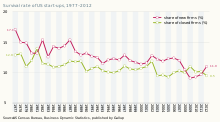
The U.S. produces approximately 18% of the world's manufacturing output, a share that has declined as other nations developed competitive manufacturing industries.[331] The job loss during this continual volume growth is the result of multiple factors including increased productivity, trade, and secular economic trends.[332] In addition, growth in telecommunications, pharmaceuticals, aircraft, heavy machinery and other industries along with declines in low end, low skill industries such as clothing, toys, and other simple manufacturing have resulted in some U.S. jobs being more highly skilled and better paying. There has been much debate within the United States on whether the decline in manufacturing jobs are related to American unions, lower foreign wages, or both.[333][334][335]
Products include wheat, corn, other grains, fruits, vegetables, cotton; beef, pork, poultry, dairy products, forest products, and fish.
Energy, transportation, and telecommunications
[edit]

Transportation
[edit]Road
[edit]The U.S. economy is heavily dependent on road transport for moving people and goods. Personal transportation is dominated by automobiles, which operate on a network of four million miles (6.4 million km) of public roads,[337] including one of the world's longest highway systems at 57,000 miles (91,700 km).[338] The world's second-largest automobile market,[339] the United States has the highest rate of per-capita vehicle ownership in the world, with 765 vehicles per 1,000 Americans.[340] About 40% of personal vehicles are vans, SUVs, or light trucks.[341]
Rail
[edit]Mass transit accounts for 9% of total U.S. work trips.[342][343] Transport of goods by rail is extensive, though relatively low numbers of passengers (approximately 31 million annually) use intercity rail to travel, partially due to the low population density throughout much of the nation.[344][345] However, ridership on Amtrak, the national intercity passenger rail system, grew by almost 37% between 2000 and 2010.[346] Also, light rail development has increased in recent years.[347] The state of California is currently constructing the nation's first high-speed rail system.
Airline
[edit]The civil airline industry is entirely privately owned and has been largely deregulated since 1978, while most major airports are publicly owned.[348] The three largest airlines in the world by passengers carried are U.S.-based; American Airlines is number one after its 2013 acquisition by U.S. Airways.[349] Of the world's thirty busiest passenger airports, twelve are in the United States, including the busiest, Hartsfield–Jackson Atlanta International Airport.[350]
Energy
[edit]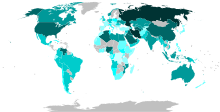
The US is the second-largest energy consumer in total use.[351] The U.S. ranks seventh in energy consumption per capita after Canada and a number of other countries.[352][353] The majority of this energy is derived from fossil fuels: in 2005, it was estimated that 40% of the nation's energy came from petroleum, 23% from coal, and 23% from natural gas. Nuclear power supplied 8.4% and renewable energy supplied 6.8%, which was mainly from hydroelectric dams although other renewables are included.[354]
American dependence on oil imports grew from 24% in 1970 to 65% by the end of 2005.[355] Transportation has the highest consumption rates, accounting for approximately 69% of the oil used in the United States in 2006,[356] and 55% of oil use worldwide as documented in the Hirsch report.
In 2013, the United States imported 2.808 billion barrels of crude oil, compared to 3.377 billion barrels in 2010.[357] While the U.S. is the largest importer of fuel, The Wall Street Journal reported in 2011 that the country was about to become a net fuel exporter for the first time in 62 years. The paper reported expectations that this would continue until 2020.[358] In fact, petroleum was the major export from the country in 2011.[359]
Telecommunications
[edit]The Internet was developed in the U.S. and the country hosts many of the world's largest hubs.[360]
International trade
[edit]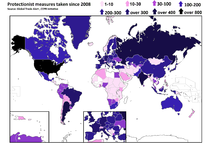
The United States is the world's second-largest trading nation.[362] There is a large amount of U.S. dollars in circulation all around the planet; about 60% of funds used in international trade are U.S. dollars. The dollar is also used as the standard unit of currency in international markets for commodities such as gold and petroleum.[363]
The North American Free Trade Agreement, or NAFTA, created one of the largest trade blocs in the world in 1994.[364][365]
Since 1976, the U.S. has sustained merchandise trade deficits with other nations, and since 1982, current account deficits. The nation's long-standing surplus in its trade in services was maintained, however, and reached a record US$231 billion in 2013.[366]
The U.S. trade deficit increased from $502 billion in 2016 to $552 billion in 2017, an increase of $50 billion or 10%.[367] During 2017, total imports were $2.90 trillion, while exports were $2.35 trillion. The net deficit in goods was $807 billion, while the net surplus in services was $255 billion.[368]
Americas ten largest trading partners are China, Canada, Mexico, Japan, Germany, South Korea, United Kingdom, France, India and Taiwan.[54] The goods trade deficit with China rose from $347 billion in 2016 to $376 billion in 2017, an increase of $30 billion or 8%. In 2017, the U.S. had a goods trade deficit of $71 billion with Mexico and $17 billion with Canada.[369]
According to the KOF index of globalization[clarification needed] and the globalization index by A.T. Kearney/Foreign Policy Magazine, the U.S. has a relatively high degree of globalization.[citation needed] U.S. workers send a third of all remittances in the world.[370]
| Balance of trade 2014 (goods only)[371] | |||||||||
|---|---|---|---|---|---|---|---|---|---|
| China | Euro area | Japan | Mexico | Pacific | Canada | Middle East | Latin America | Total by product | |
| Computer | −151.9 | 3.4 | −8.0 | −11.0 | −26.1 | 20.9 | 5.8 | 12.1 | −155.0 |
| Oil, gas, minerals | 1.9 | 6.4 | 2.4 | −20.8 | 1.1 | −79.8 | −45.1 | −15.9 | −149.7 |
| Transportation | 10.9 | −30.9 | −46.2 | −59.5 | −0.5 | −6.1 | 17.1 | 8.8 | −106.3 |
| Apparel | −56.3 | −4.9 | 0.6 | −4.2 | −6.3 | 2.5 | −0.3 | −1.1 | −69.9 |
| Electrical equipment | −35.9 | −2.4 | −4.0 | −8.5 | −3.3 | 10.0 | 1.8 | 2.0 | −40.4 |
| Misc. manufacturing | −35.3 | 4.9 | 2.7 | −2.8 | −1.4 | 5.8 | −1.5 | 1.8 | −25.8 |
| Furniture | −18.3 | −1.2 | 0.0 | −1.6 | −2.1 | 0.4 | 0.2 | 0.0 | −22.6 |
| Machinery | −19.9 | −27.0 | −18.8 | 3.9 | 7.6 | 18.1 | 4.5 | 9.1 | −22.4 |
| Primary metals | −3.1 | 3.1 | −1.8 | 1.0 | 1.9 | −8.9 | −0.9 | −10.4 | −19.1 |
| Fabricated metals | −17.9 | −5.9 | −3.5 | 2.8 | −4.3 | 7.3 | 1.2 | 1.9 | −18.5 |
| Plastics | −15.7 | −1.9 | −2.0 | 5.7 | −4.1 | 2.6 | −0.1 | 0.5 | −15.0 |
| Textile | −12.3 | −1.1 | −0.3 | 2.8 | −4.6 | 1.5 | −0.9 | 0.2 | −14.7 |
| Beverages, tobacco | 1.3 | −9.9 | 0.6 | −3.3 | 0.0 | 1.0 | 0.2 | −0.6 | −10.6 |
| Nonmetallic minerals | −6.1 | −1.9 | −0.4 | −1.2 | 0.1 | 1.9 | −0.5 | −0.8 | −8.9 |
| Paper | −2.7 | 1.2 | 1.1 | 4.3 | 1.2 | −9.8 | 0.9 | −1.9 | −5.8 |
| Chemical | −3.9 | −39.5 | −1.5 | 19.1 | 3.2 | 4.6 | −2.4 | 15.8 | −4.7 |
| Food | 0.7 | −3.6 | 6.1 | 4.9 | 0.9 | 0.1 | 1.4 | −1.1 | 9.5 |
| Agriculture | 17.8 | 6.2 | 7.3 | −3.0 | 5.7 | −0.8 | 2.8 | −6.5 | 29.5 |
| Petroleum | 0.6 | −1.2 | 0.1 | 16.6 | −2.0 | −0.1 | 0.6 | 18.3 | 32.9 |
| Total by country/area | −346.1 | −106.1 | −65.6 | −54.9 | −33.0 | −29.0 | −15.1 | 32.3 | |
Financial position
[edit]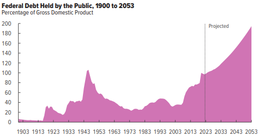
The U.S. public debt was $909 billion in 1980, an amount equal to 33% of America's gross domestic product (GDP); by 1990, that number had more than tripled to $3.2 trillion – 56% of GDP.[372] In 2001 the national debt was $5.7 trillion; however, the debt-to-GDP ratio remained at 1990 levels.[373] Debt levels rose quickly in the following decade, and on January 28, 2010, the U.S. debt ceiling was raised to $14.3 trillion.[374] Based on the 2010 United States federal budget, total national debt will grow to nearly 100% of GDP, versus a level of approximately 80% in early 2009.[375] The White House estimates that the government's tab for servicing the debt will exceed $700 billion a year in 2019,[376] up from $202 billion in 2009.[377]
U.S. household and non-profit net worth exceeded $100 trillion for the first time in Q1 2018; it has been setting records since Q4 2012.[378] The U.S. federal government or "national debt" was $21.1 trillion in May 2018, just over 100% GDP.[379] Using a subset of the national debt called "debt held by the public", U.S. debt was approximately 77% GDP in 2017. By this measure, the U.S. ranked 43rd highest among 2017 nations.[380] Debt held by the public rose considerably as a result of the Great Recession and its aftermath. It is expected to continue rising as the country ages towards 100% GDP by 2028.[381] In February 2024, the total federal government debt grew to $34.4 trillion after having grown by approximately $1 trillion in both of two separate 100-day periods since the previous June.[382]
The U.S. Treasury statistics indicate that, at the end of 2006, non-US citizens and institutions held 44% of federal debt held by the public.[383] As of 2014[update], China, holding $1.26 trillion in treasury bonds, is the largest foreign financier of the U.S. public debt.[384]
The overall financial position of the United States as of 2014 includes $269.6 trillion of assets owned by households, businesses, and governments within its borders, representing more than 15.7 times the annual gross domestic product of the United States. Debts owed during this same period amounted to $145.8 trillion, about 8.5 times the annual gross domestic product.[385][386]
Since 2010, the U.S. Treasury has been obtaining negative real interest rates on government debt.[387] Such low rates, outpaced by the inflation rate, occur when the market believes that there are no alternatives with sufficiently low risk, or when popular institutional investments such as insurance companies, pensions, or bond, money market, and balanced mutual funds are required or choose to invest sufficiently large sums in Treasury securities to hedge against risk.[388][389] American economist Lawrence Summers argues that at such low rates, government debt borrowing saves taxpayer money, and improves creditworthiness.[390]
In the late 1940s through the early 1970s, the US and UK both reduced their debt burden by about 30% to 40% of GDP per decade by taking advantage of negative real interest rates, but there is no guarantee that government debt rates will continue to stay so low.[388][391] In January 2012, the U.S. Treasury Borrowing Advisory Committee of the Securities Industry and Financial Markets Association unanimously recommended that government debt be allowed to auction even lower, at negative absolute interest rates.[392]
Currency and central bank
[edit]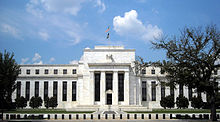
The United States dollar is the unit of currency of the United States. The U.S. dollar is the currency most used in international transactions.[393] Several countries use it as their official currency, and in many others it is the de facto currency.[394]
The federal government attempts to use both monetary policy (control of the money supply through mechanisms such as changes in interest rates) and fiscal policy (taxes and spending) to maintain low inflation, high economic growth, and low unemployment. An independent central bank, known as the Federal Reserve, was formed in 1913 to provide a stable currency and monetary policy. The U.S. dollar has been regarded as one of the more stable currencies in the world and many nations back their own currency with U.S. dollar reserves.[46][47]
The U.S. dollar has maintained its position as the world's primary reserve currency, although it is gradually being challenged in that role.[395] Almost two thirds of currency reserves held around the world are held in U.S. dollars, compared to around 25% for the next most popular currency, the euro.[396] Rising U.S. national debt and quantitative easing has caused some to predict that the U.S. dollar will lose its status as the world's reserve currency; however, these predictions have not yet come to fruition.[397]
Corruption
[edit]In 2019, the United States was ranked 23rd on the Tran

